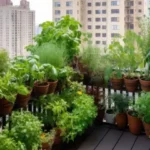As you start exploring container gardening ideas, you may face the challenge of needing more space. You may want to grow your favorite zinnia flower, but the available area limits you. Don’t worry; I’m here to give you helpful advice and information to help you grow zinnias in pots.
Choose the right pot size for these beautiful and intriguing flowers, typically around 12 inches or 30 cm in diameter. Ensure your container has good drainage and is made from suitable materials like terra cotta, ceramic, and plastic. It’s best to start zinnia seeds indoors while allowing them to receive total sun exposure. Keep the soil moist and deadhead the flowers regularly to encourage more growth.
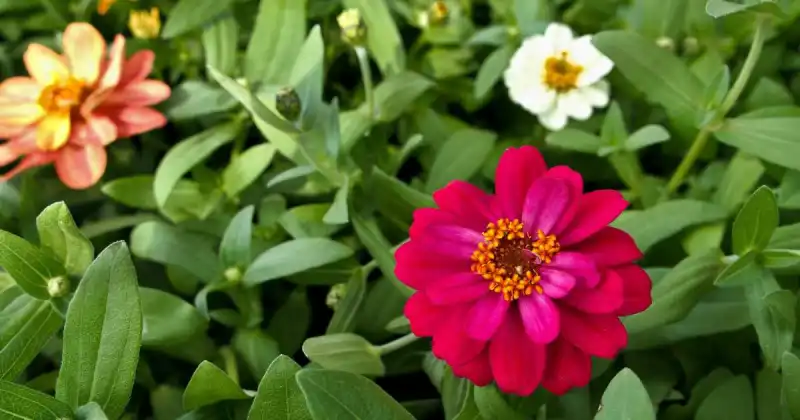
Fortunately, zinnias are incredibly easy to grow and produce stunning flowers. I will guide you through the simple steps to grow zinnias in pots in this article. From choosing the right size and materials to providing proper care, you’ll be well-equipped with the knowledge to create a stunning garden filled with these gorgeous blooms. Let’s dive in and discover the joy of growing zinnias in containers like pots without further ado!
Humble Highlights
- Discover these 5 benefits of zinnias to enjoy these beautiful blooms anywhere in your garden!
- Save money by choosing the best pots and for your zinnias with these 3 primary container advantages so you can boost their growth and health!
- Save time with this step-by-step zinnia growing guide to get back to what’s really important – enjoying these delightful and breathtaking flowers.
Planting Zinnias In Pots: Great Container Garden Options
Growing zinnias in pots have many advantages, especially if you have a small balcony or patio. Zinnias are great plants to grow in containers because you can use all kinds, including clay or terracotta pots, wooden boxes, plastic or concrete pots, and even hanging baskets. However, we’ll mainly talk about using regular pots here.
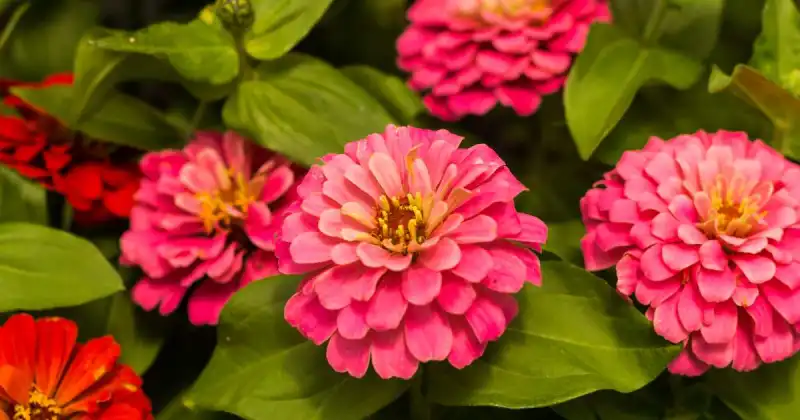
Now, let’s explore some benefits you’ll experience and how to care for them as you cultivate these fantastic flowers.
Compact Size And Versatility
Zinnias are suited for container gardening due to their compact size. Most zinnia varieties grow to around 12 to 18 inches tall and wide. They also feature outstanding heat and drought tolerance, ideal for smaller spaces such as balconies, patios, urban rooftops, or windowsills. 1
Portability
Potted zinnias are mobile, meaning you can quickly move them around as needed and arrange them whenever you want. This flexibility enables you to create dynamic arrangements and change the visual composition of your garden aesthetics whenever desired.
Long Bloom Cycle
When we talk about the “long bloom cycle” of zinnias, we’re referring to how long these flowers stay in bloom. Zinnias are known for their ability to produce flowers for an extended period, meaning you can enjoy their beautiful blossoms from late spring through the first frost in the fall or winter.
Unlike plants that may bloom for a few weeks, zinnias keep producing flowers in containers throughout the growing season, regardless of your climate or weather patterns. Additionally, you don’t have to worry about your flowers wilting or losing their colors quickly, as zinnias keep brightening up your space and are relatively resilient.

Wide Variety Of Colors And Shapes
Zinnias are colorful and pretty flowers in many colors, like red, orange, pink, yellow, purple, and white. They also have different petals, some with just one layer and others with multiple layers. With this variety, zinnias add lots of color and personality to your garden, making it stand out. 2
Some popular short zinnia cultivars include Zahara, Solcito, and the Raspberry Lemonade Mix. However, you can also opt for dwarf varieties like Small World, Dasher, and Thumbelina, which usually only grow about 6 inches tall.
Attract Pollinators And Butterflies
Another great thing about zinnias for container gardening is that they attract helpful bugs like bees, ladybugs, and butterflies. These beneficial critters are essential because they help pollinate your green space by eating nectar, a magnet for these garden helpers.
How Long Do Zinnias Take To Grow
Zinnias have a relatively fast growth rate compared to other vegetables and flowers. When you sow the seeds, they typically take about 7 to 10 days to emerge. These seedlings will continue to grow and develop over the next few weeks, and you can expect to see the first flowers appearing within 8 to 10 weeks.
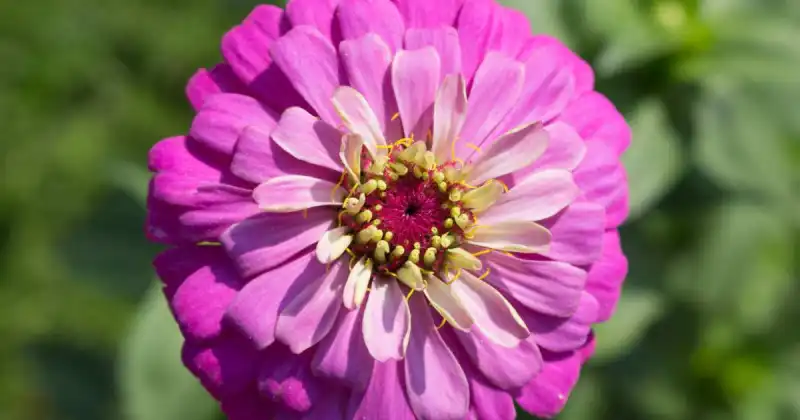
The exact time it takes to reach maturity and start flowering can vary depending on the specific zinnia variety, conditions, and climate. 3
Right Pot For Zinnias To Grow
There are three primary points when it comes to ensuring your zinnias get off to the best start, including:
- Selecting The Right Size Pot
- Ensuring Your Pot Is Well-Draining
- Material Of The Pot
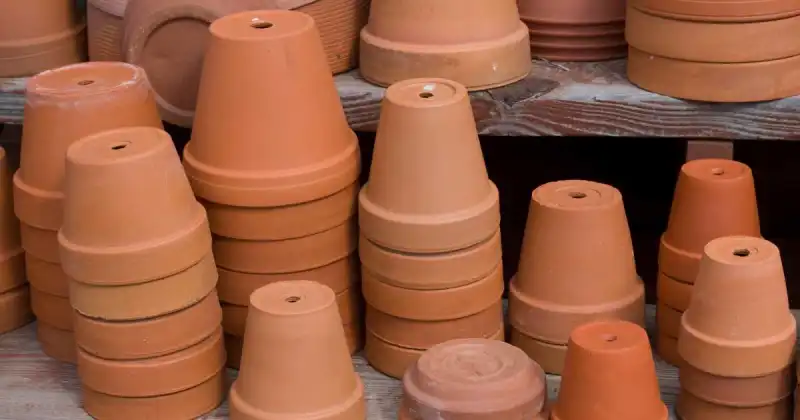
Suitable Pot Size
When mature, zinnias generally require at least 12 inches (30 centimeters) in diameter and depth to allow their root system to expand and spread so it doesn’t become restricted and hinder development.
However, it’s best to choose shorter varieties of zinnias rather than taller options for container growing to offer them suitable space to flourish. When in doubt, choose a slightly larger pot to ensure ample room for these plants to thrive.
Well-Draining Pot
Choosing a well-draining pot is vital because it helps prevent water from collecting at the bottom and potentially causing mold, root rot, and other plant diseases. When water can freely and efficiently flow through drainage holes, it avoids soil compaction, which can suffocate the roots. 4
Just like we need to breathe fresh air, roots too, enjoy fresh oxygen. A sufficient water-draining pot ensures your zinnias receive enough oxygen, creating a healthy environment for your greenery.
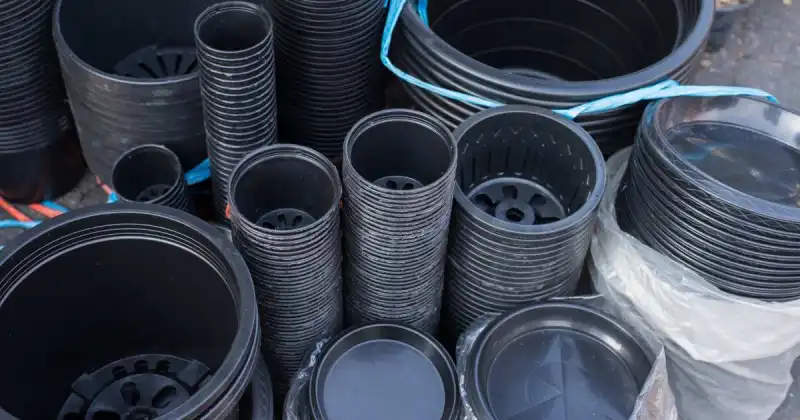
Pot Material
Regarding the materials used for pots, there are different options available. Standard gardening containers may comprise plastic, clay, ceramic, and metal materials, each with pros and cons.
- Plastic is lightweight, durable, and retains moisture but may leach chemicals into the soil that may harm your plants.
- Clay is porous, allowing sufficient airflow to the roots, but can dry out quickly.
- Ceramics are aesthetically pleasing and retain moisture, but they can be heavy.
- Metal can be durable but may heat rapidly in the sun, burning delicate rooting systems.
Of course, choosing the suitable material depends on your preferences and factors, including climate and the specific needs of the type of zinnia you select.
Proper Soil Mix
Zinnias require fertile and well-draining soil for optimal growth. Fertile soil provides these plants with essential nutrients to reproduce their vibrant blooms. Well-draining soil prevents water from becoming stagnant, preventing root rot and other issues that can stunt growth and cause plant death.
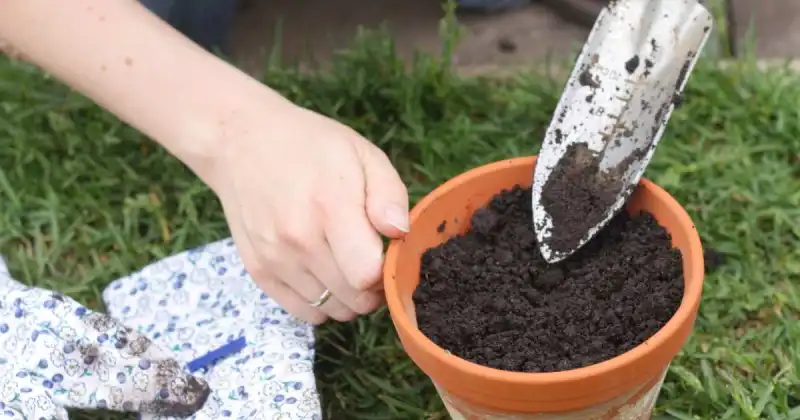
Selecting a premixed potting soil is a convenient option. These soils offer excellent drainage and are specifically formulated to provide a balanced mix of nutrients, including peat moss, perlite, vermiculite, minerals, and organic matter. 5
Start Zinnia Seeds Indoors
Growing these lovely flowers from seeds is exceptionally simple. You can easily buy a packet of zinnia seeds and plant them directly into the potting soil of your container. Plant the seeds in small pots or trays inside your house before transferring them to your outdoor garden to help protect them from the elements and potential outdoor temperature swings.

Next, place the containers in a warm and sunny spot in your home, near a window, or under a grow light. The seeds need consistent moisture to germinate and root appropriately, so water them regularly, ensuring the soil stays moist and cool to the touch. 6
Time To Grow: Planting Time For Zinnias
The perfect time for zinnias is when the danger of frost has passed and the weather becomes consistently warm. Remember, zinnias are warm-season flowers and require temperatures above freezing, preferably around 70 to 75 degrees Fahrenheit (21 to 24 degrees Celsius).
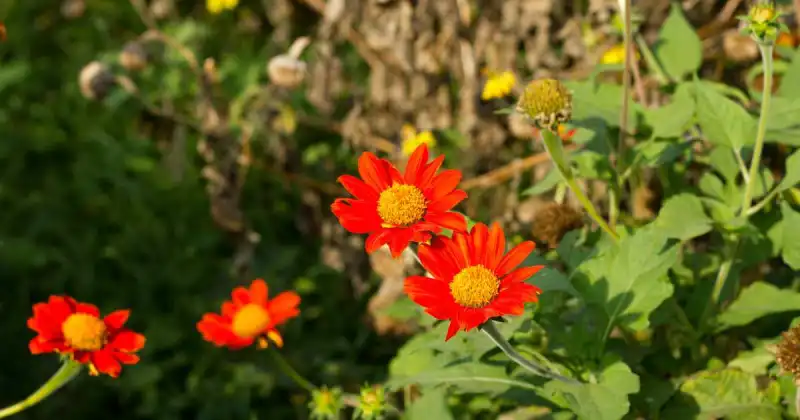
Although it’s important to check your region’s last average frost date, permanently moving zinnias outdoors is usually safe after the last one in your area. Depending on your region, this usually occurs in spring or early summer. 7
Spacing And Depth
When planting zinnias, space them according to the specific variety you’re growing. Generally, these flowers enjoy space to spread their blooms. A good rule of thumb is to place each plant about 6 to 18 inches (15 to 45 centimeters) apart.
The depth, however, depends on the size of the zinnia seeds. Typically, it’s good practice to sow seeds about ¼ to ½ inch (0.6 to 1.3 centimeters) deep. As always, follow the instructions on the seed packet for precise spacing and depth.
Required Sun Exposure
Zinnias require at least 6 to 8 hours of direct sunlight daily to grow and bloom. Sunlight is like food for plants, activating the photosynthesis process and providing your plants with needed energy. Because zinnias thrive in full sun, providing a sunny location is imperative. As your zinnias are potted, consider moving them in accordance with the sun to keep the light supply generous.
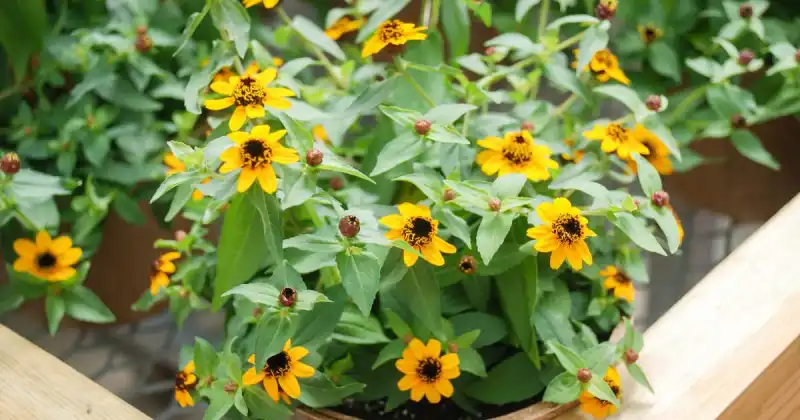
Moving Pots For Optimal Sunlight
As mentioned, if your zinnias aren’t getting enough sunlight in their current location, you can move them. You can place the pots in different spots throughout the day to ensure they get the maximum sunlight. 8
Zinnias typically bloom from late spring or early summer through fall. So, if you want your potted zinnia to grow healthy and produce lots of beautiful flowers, may it be in the growing season or not, make sure they get the full sun they need.
What Zinnias Need To Bloom: Watering And Maintenance
The best things you can do to ensure your zinnias develop a healthy bloom include keeping the soil moist and being mindful of pests or diseases that may target and attack your plants.
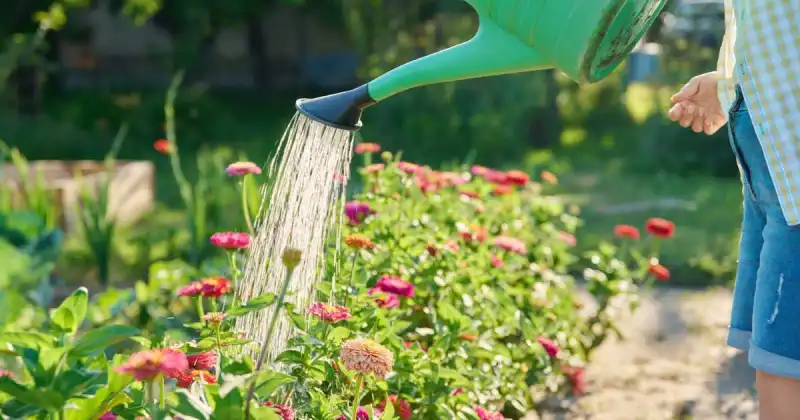
Watering Needs
Zinnias will stay healthy and bloom nicely when regularly watered. The soil should be kept consistently moist but not overly soaked to prevent your young zinnias from drowning.
It’s also important to regularly check the soil and water when it feels dry. Like any plant, watering zinnias at the bottom or base rather than from above helps prevent diseases by keeping the flowers and foliage dry. 9
Common Pests And Diseases
Although zinnias grow well in pots, they can still be susceptible to certain pests and diseases that may affect their growth and flowering. Some common pests include aphids, spider mites, and whiteflies. These pests can be controlled by insecticidal soaps or sprays or by introducing beneficial insects that prey on them, like ladybugs.
As for diseases, zinnias can be affected by powdery mildew, which appears as a fine white powdery coating on the leaves. To prevent diseases, provide sufficient air circulation, space your plants accordingly, avoid overhead watering, and remove any infected parts.
Deadhead To Prolong Zinnia Plant Flowering
Deadheading removes old and faded flowers from your zinnia plants to encourage them to drive energy production to new blooms. After the zinnia flowers start to wither, wilt, and lose their classic vibrant colors, you should remove them by cutting or pinching them off.
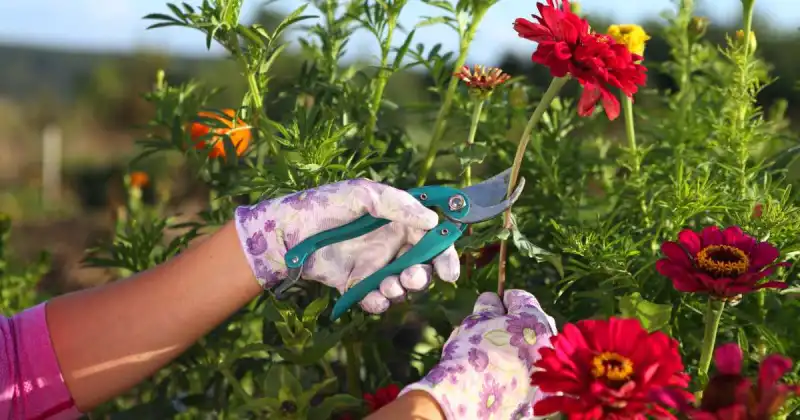
Gardeners often pinch field-grown zinnias to encourage longer stems, ideal for creating beautiful flower arrangements. This process helps zinnias stay attractive and in bloom for extended periods. 10
Step-By-Step Tips For Growing Zinnias
Here’s a quick and efficient guide for growing zinnias at home.

- Choose a suitable pot. The container should have adequate drainage holes, at least 12 inches wide and deep, and be filled to the top with a premium potting soil mix.
- Moisten soil. Before sowing your zinnia seeds, ensure the soil is slightly moist. Soil shouldn’t be too wet or dry but somewhere in the middle.
- Sow your seeds. Place the seeds in the soil, spacing them according to the packet instructions if you have a longer container, like a box planter. Press them about ½ inch deep into the ground, ensuring you don’t bury them too deep.
- Cover your seeds. After sowing, seeds should be covered with a quarter-inch (0.5 cm) of soil. Once done, lightly water the soil and seeds. 11
- Find a sunny spot. Put the pot in a sunny location, like a windowsill or under artificial grow lights. Zinnias need plenty of sunlight to grow to their full potential.
- Water your zinnias regularly. Zinnias love moisture, so keep your soil evenly moist while avoiding overwatering.
- Thin your flowers. As your zinnias mature, thin them out if needed, removing weaker seedlings to provide enough space for the remaining flowers to thrive.
As a humble gardener, it may be painful to thin out your zinnias. And even though it may be a disheartening practice, it’s best in the long run that your plants have enough space between them to stretch out to help discourage disease and pest challenges. The best time to thin zinnias is when they are between 2 and 3 inches tall.
Conclusion
To grow and care for zinnias is quite a breeze, and the rewards are stunning blooms that last a long time. Zinnias are like little bundles of happiness, bringing vibrant colors and joy to your garden or home. Whether you’re an experienced gardener or a newbie, zinnias are a perfect choice.
The best part is you don’t need a big garden! You only need a pot, some soil, and a sunny spot. It’s a fantastic way to get closer to nature and create a lively haven in your space.
Do you grow zinnias in your garden oasis? We’d love to know how you care for these stunning flowers. Take a moment now and drop us a line in the comments below!
SOURCES
- University Of Minnesota, Extension – Zinnia
- Mississippi State University, Extension – Profusion Zinnias Give Strong Color All Summer
- Wikipedia – Zinnia
- The Royal Horticultural Society – How To Grow Zinnia
- Utah State University, Extension – Zinnia Cut Flower Production In Utah
- North Carolina State University, Extension – Zinnia
- Almanac – First And Last Frost Dates
- Almanac – Zinnias
- Michigan State University, Extension – Growing Zinnias In Your Flower Garden
- University Of Wisconsin-Madison, Division Of Extension – Zinnias
- University Of Florida, Gardening Solutions – Zinnia

